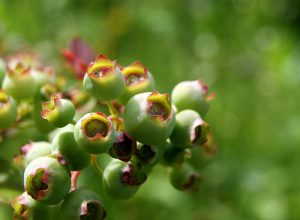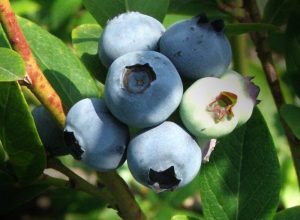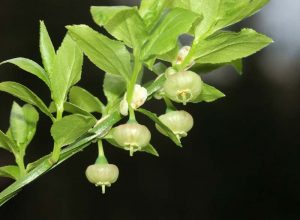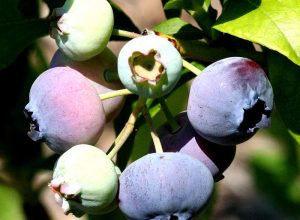Giant American Blueberry – Vaccinum Corymbosum


Spontaneous in the Northern Hemisphere between 500/800 and 1,500/1,800 metres, the small Blueberry plant you frequently found in our woods belongs to the Vaccinium genre (Ericacee family) of which you can find more than 100 species:from the carpeting red Cranberry (see) not more than 30 cms to the North American Arboreum which can reach up to 9/10 metres.
The common blueberry from our woods, (Vaccinium myrtillus) is difficult to cultivate because of its natural habitat and its modest size, However within the numerous species of this genre, the Giant American Blueberry (Vaccinium Corymbosum).
This Shrub has deciduous leaves and can reach a height of 2/3 metres and with a diameter of generally the half of that, with frequent shoots and rapid development which starts at the base giving it the poise of a bush which fruits the next year.
The plant resists extreme cold very well, but the vigorous shoots which in Spring begin at ground level take the whole season to lignify, and so in regions with intensely cold climates where it gels early on and consequently it is difficult to obtain good, healthy examples of harvest.
The blueberry has a peculiar root system: made up of few roots of large size and from a dense lattice of very delicate roots, this allows for a pretty sure transplant even with large sized plants and not prepared in advance.
They are sun lovers which allows the fruit to obtain high levels of sugar, but in an environment where they are not excessively exposed, they require being exposed to the light so as to permit better blooming and as a consequence a better harvest.
TERRAIN
Different to all other summer fruit which enjoy a neutral subsoil / semi acid, the blueberry needs a very acid soil, with an excellent ph which oscillates between 4.0 and 4.5 with limited toleration of 5.5, well drained, fresh and rich in humus, which is indispensable to be well aware of the basic characteristics of where you want to plant it.
Whatever the soil, not having a suitable ph, you can correct it at the moment of planting with a spread of acid torba or with pine needles or well composted beech tree leaves and renewing the substratum at the beginning of the cold season being very careful not to ruin the very superficial root system.


FLORA AND FRUIT
In early Spring numerous pinkish white flowers appear in small bunches, round with the petals united amonst themselves, characteristic of all the flowers of the ericacee.
Which at first are green, then purple, almot blue, generally covered in a light wax (see Siberiano blueberry) which can reach a certain point of cultivation, even two cms diameter.
In reality they are false berries: this is because they have a diverse formation to that of the real berry.
USE AND HEALTH GIVING PROPERTIES
Easily preserved in the freezer, they are eaten fresh, in fruit salad pastries,jams; its use in the pharmaceutical and para pharmaceutical industry is important.
Of all the summer fruit, the blackberry is surely the most important from the point of view of health giving properties: apart from the exquisite taste, it has many properties which makes it one of the main pharmafoods (see Cranberry). Vitamin C, carotenoid, tannin, catechitini ( a molecule with astringent properties), hemostatic, antibiotics, antidiarrheal, and antiinflamatory), pectin (see gooseberry) are some of the contents of the blackberry.
But it is the presence of antociani (see Siberian Blueberry), potent antioxidant it is noted for its capillary properties which make this small fruit a cure-all for the physique and the cardiovascular system specifically.
By capillary properties we mean the characteristic of the main active contained in a substance or a food, able to improve the resistance and function of the capillaries.
In any chemist’s we can find derivative products from the blackberry for the cure and prevention of colds and re-enforcement of the blood vessel walls.
According to the RDA (see Goji), the blackberry is among the fruit with the highest points (3.750) after the pomegranate (10.500) the Goji( 15.000).
PRUNING AND CULTIVATION
Very important that the characteristics of the soil meet the needs of the plant.After this premise is also simple the description of the necessary care because you will have a strong and vigorous plant without major interventions. The first years of the plants , they will work a lot of roots, while the aerial apparatus will give the impression almost suffering.
In this period, about 1/2 years, the production will be modest as well as the prunings that are realized with the cutting of the low lateral branches and in the total removal of the weakest branches.
After this period, we will proceed to the thinning of the weakest vegetation from the base and the cut of damaged or broken branches and on the remaining we will proceed with return cuts to the more vigorous side branches.
Moreover, those branches which, although healthy and beautiful, will have a disorderly and disordered growth will be cut.
Since the root system is very superficial, irrigation is very important, especially during the period from flowering to harvesting the fruit.
Be careful not to stagnate the water, which would lead to the formation of fungi that would cause the roots to rot.
To retain moisture, and at the same time keep the soil clean and acid, we recommend mulching with sour peat or pine needles or beech leaves.
With the precautions described above the fertilizations should not be used, but if there were any shortcomings, an input at the beginning of the ternary fertilizer season with low nitrogen content and containing the main microelements, will certainly be effective.
Never use the manure, even if very mature: the plant would suffer from ferric chlorosis and as a result, it could also die.
There are few parasites: the most dangerous is the oziorinco (Otiorhyncus ssp), a small beetle that gnaws its leaves from an adult and lays its eggs on the ground; the larva that derives from it eats the roots and, much more serious, it gnaws the collar of the plant causing its death.
With particular weather conditions, gray mold attacks (Botrytis) on the fruits close to ripening are possible, but since they can not be treated with pesticides the only solution is the manual removal of the affected fruits.
Please note that the collaborators of PRANDINI nurseries are available for advice on plant density, form of breeding, crop choice and also phytosanitary assistance for new production plants even of modest size.
